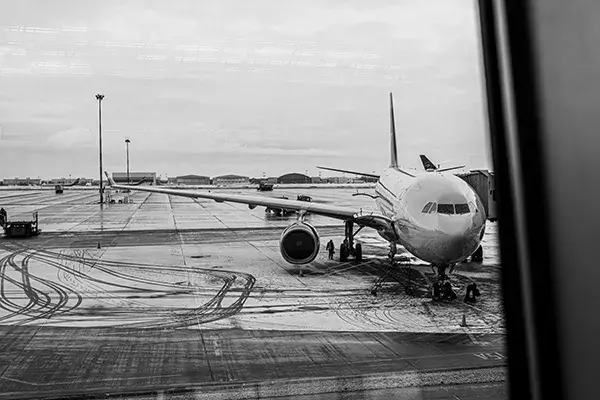27 July 2023 | Blog
From chaos to confidence: 5 top tips for managing airline disruption
27 July 2023 | Blog
From chaos to confidence: 5 top tips for managing airline disruption
The last few years have presented the aviation industry with a set of challenges that nobody could have predicted, followed by soaring levels of demand which have caught out many. As global passenger traffic has now reached 90% of pre-Covid levels, airline disruption has become more frequent than ever.
Handling these situations appropriately - with the customer at the heart of the response is crucial for maintaining a brand's reputation. While preventing delays and cancellations may not always be possible, there is no excuse for failing to help passengers make the most of a bad situation.
“The cause of the disruption becomes less important – be it severe weather conditions or a misplaced bag – it really all comes down to how an airline or an airport handles the problem at hand. This is where you can make a difference. It becomes an opportunity.”
Hasse Joergensen, formerly Senior Manager, Passenger Experience, IATA
Passengers now expect personalised experiences and constant updates throughout their journey, and failing to deliver this can lead to reputational damage and an impact that can be seen all the way down to the bottom line.
We've recently created a comprehensive white paper 'The future of disruption communications' and as part of this, we shared five solutions to help overcome some of the challenges airlines are facing when it comes to handling flight disruption. Read a summary of these below:
1) Contact details are crucial

Passengers want real-time notifications if their flight schedule is disrupted – and airlines that focus on the completeness of their database will be in the strongest position to meet their customers’ demands.
A lot of travellers have no idea that booking through a third party will impact the information they receive, so communicating this wherever possible is vital. Remind customers via your website, app, or booking management area to update their booking with contact details so that you can quickly, easily, and reliably reach them if you need to share an important update about their flight.
Top tip for airlines:
Making contact details mandatory at check-in is a good idea. Linking bookings to other profile databases such as loyalty and CRMs is also a key way that we help our airline customers to capture vital contact details. In fact, our technology looks at 16 different fields to find and validate contact details in real-time. And, if we find a travel agent’s details our algorithms are set up to look in multiple other systems – like your loyalty programme, for instance – to update this information.
2) Multichannel communication is expected

Using a combination of communication channels is a tactic that best-in-class airlines employ to keep their passengers informed and empowered at every stage of their journey.
By communicating via several channels, in the traveller’s native language, airlines can help to build trust with their passengers, particularly during times of high stress. Take nasty surprises out of the journey by being proactive about keeping your passengers informed and empowered and the result will be increased loyalty, improved NPS, and the ability to charge up to a 16% price premium.
Top tip for airlines:
Three channels should be tried for each communication so that if the first channel doesn’t work, the second is tried and so on. Finally, if the passenger is unreachable by all three channels, a member of staff should be tasked with contacting them directly.
3) You need a balance between humans and technology

Airlines are embracing digital trends to meet customers’ demands and keep passengers informed. However, automation technology is not there to replace humans, but to take the pressure off staff whilst giving customers more control. While technology offers consistency, speed, and accuracy, it cannot replace the empathy, social interaction and ability to manage unique cases that humans provide.
Top tip for airlines:
The key to managing disruption effectively is proactivity. Use automation to keep your passengers informed before they go looking for information. This will reduce queues and calls, ensuring your people are not overwhelmed so that they can provide a concierge-style experience for those that need it.
4) Personalisation is not enough

Hyper-personalisation is about more than remembering your passenger’s first name and birthday. That comes as standard. Hyper-personalisation allows you to engage with each and every one of your customers with messaging tailored to them. Whether your passenger is a VIP, has been disrupted before, has small children, or special-service requirements, your communications should give them all the information they need before they have to go looking for it.
To create an experience for the guest that makes them feel empowered and secure, your workflows must also take context into consideration as well as personalisation. Understanding how a guest feels, in this situation is critical to showing empathy and gaining trust.
Top tip for airlines:
This is achieved through granular and complex workflows and business rules as well as template personalisation. Your aim should be to have one template within which the content dynamically changes depending on who your customer is, where they’re going, and when. Having just one template to work with will eliminate human error as you won’t have infinite variations to manage.
5) Data integration with the right tool for the right job

It is essential that the booking is linked with other data sources so that they can work together to create a detailed picture of each passenger.
If you rely solely on a marketing or CRM database to manage your passengers’ contact details, then it’s likely a significant proportion is out of date. A common challenge with using these types of platforms to send operational communications is the time it takes the user to manually download and upload data from one system into another: Within just a few hours the status of many passengers will have changed and you’ll be sending irrelevant or incorrect information. The result will be confused passengers putting unnecessary (and costly) strain on your operations teams.
Top tip for airlines:
You should be using live data direct from your reservation system, which will be changing all the time. Loyalty members will expect their profile data to be used in booking-related communications. Plus, CRM and other systems need to be updated automatically with what has happened to guests when they travel. Ensuring the data is passed between systems smoothly and in-real-time means all customers will receive the right information at the right time.
What's next for flight disruption communications?
Forward-thinking airlines rely on technology to proactively reach affected passengers at the perfect time with all the information they need. In fact, many of the world’s top carriers, including Ryanair, JetBlue and Qantas have found that the key to effective communications during periods of disruption is automation.
Our white paper 'The future of disruption communications' will help you learn how a strong passenger communications strategy combined with the right technology can help deliver a best-in-class experience that both empowers and delights your passengers. Click below to read it now:




